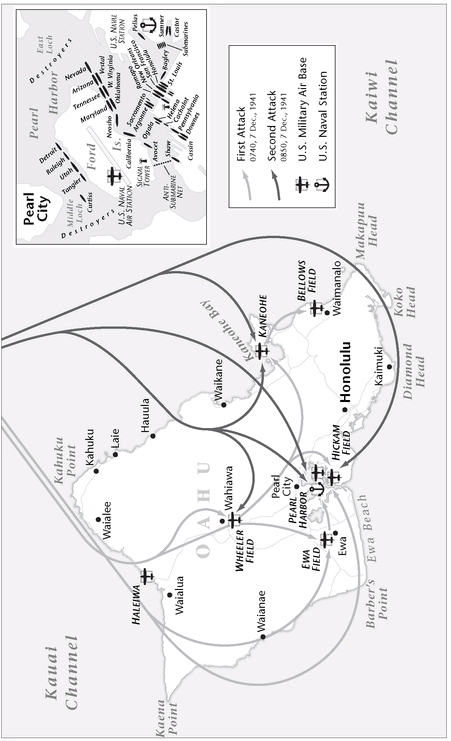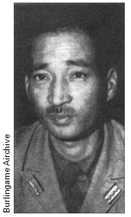War Stories II (2 page)
Authors: Oliver L. North

Many of them didn't even know where this Hawaiian naval base was when they first heard about the raid. But everyone knew what it meant: America was now in the war that most had hoped to avoid.
In the days after the attack, newspapers, magazines, and newsreels at local movie theaters quickly educated the American people about the geography of Hawaiiâand the damage that had been done to America's Pacific Fleet. That same “Remember Pearl Harbor!” rallying cry became a call to battle for the legions of young men showing up at recruiting and induction centers.
It was a slogan that stuck, all the way across the broad expanse of ocean and the bloody battles of what came to be called the Pacific theater of war. Newspapers printed full-page maps of the region, and families tacked them up on kitchen and living room walls so that sweethearts, wives, parents, and siblings could keep track of where their loved ones were serving in the far reaches of that vast ocean. Tiny dots on those maps and locations with unpronounceable names became places to pray about in churches and weep over in the privacy of bedrooms.
The ocean that spanned those maps was anything but pacific during World War II. From the opening shots fired here at Pearl Harbor to the armistice signed in Tokyo Bay three years, eight months, and twenty-four days later, this body of water and its islands were the venue for the biggest air and naval engagements in history and some of bloodiest land battles ever fought.
The enemy that America was pitted against in the Pacific proved to be an implacable foe. Unlike our European adversariesâthe Vichy French, Mussolini's Italian Legions, or the German Wehrmachtâno Japanese Imperial Army unit ever surrendered until the armistice was signed on the deck of the USS
Missouri
on 2 September 1945. The Japanese literally fought to the death.
Missouri
on 2 September 1945. The Japanese literally fought to the death.
Whether they served on air, land, or sea, the young Americans sent off to contend with the Japanese army, navy, and air force proved to be a remarkable lot. They are men and women often described in superlatives. Most were born in the aftermath of The War to End All Wars, were toddlers in the Roaring Twenties, and came of age during the Great Depression. Though few were unaffected by these events and the global economic catastrophe that began in America with the stock market crash of 1929, nearly all I've known have possessed a remarkable sense of optimism.
This generation grew up in an America that was still overwhelmingly rural. Their sources of information on current events were newsreels at neighborhood movie theaters, hometown newspapers, radio, and discussions over the family kitchen table. They matured in the harsh reality of “hard times:” devastating droughts in our agricultural heartland, massive Depression-induced unemployment, and increasing uncertainty as Bolshevism swept across Russia and Fascism took hold in Italy, Japan, Spain, and Germany.
Though most of those I interviewed for our
War Stories
documentaries and this book were just teenagers as war clouds gathered and broke over Asia and Europe in the 1930s, nearly all were familiar with the intrigues and events leading up to the conflagration. Yet few of them expected that America would be plunged into that awful cauldron. Most believed, as did their
parents, that the broad, blue waters of the Atlantic and the Pacific insulated them from the troubles in faraway lands. Many cited the promises made by politicians of every persuasion who assured the American people that what was happening “over there” wasn't our fight.
War Stories
documentaries and this book were just teenagers as war clouds gathered and broke over Asia and Europe in the 1930s, nearly all were familiar with the intrigues and events leading up to the conflagration. Yet few of them expected that America would be plunged into that awful cauldron. Most believed, as did their
parents, that the broad, blue waters of the Atlantic and the Pacific insulated them from the troubles in faraway lands. Many cited the promises made by politicians of every persuasion who assured the American people that what was happening “over there” wasn't our fight.
Late in summer 1941âwith Hitler dominating Europe and on the march toward Moscow, with Japanese forces controlling most of the Chinese coast and occupying Indochina, and with Britain being bombed dailyâCongress began deliberations on the Selective Service Extension Act. The bill, authorizing the movement of American military personnel overseas and extending their term of service, was considered by opponents to be “jingoistic,” “warlike,” and too “provocative” for a “neutral nation.” The hotly contested debate reflected the ambivalence of the American people on the issue of our involvement in “someone else's war.” On 12 August 1941, the law passed the House of Representatives by a single vote.
Fewer than four months later, the attack on Pearl Harbor erased those uncertainties. For the young Americans already in serviceâand those now called up by the millionsâit soon became obvious that while the war in Europe would be an Allied effort, the fight in the Pacific theater would be a predominantly American affair. They also quickly learned that they would face years of separation from those they loved, and they confronted the terrible prospect of death in a strange-sounding spot in the middle of an ocean most had never seen.
This book is about them. This isn't a book about warâit's about warriors. It isn't really a history book. It's about those who
made
historyâthe young Americans from every walk of life, from every part of this great nation, who came to serve with the words “Remember Pearl Harbor!” ringing in their ears.
made
historyâthe young Americans from every walk of life, from every part of this great nation, who came to serve with the words “Remember Pearl Harbor!” ringing in their ears.
Their self-effacing modest words are offered here as a memorial to heroic sacrifice in the crucible of dramatic and often deadly events that began with the attack on Pearl Harbor and ended with Japan's surrender in Tokyo Bay. Theirs is a war story that deserves to be told.

CHAPTER 1
WHO FIRED FIRST?
(7â8 DECEMBER 1941)
 PEARL HARBOR, HAWAII
PEARL HARBOR, HAWAIISUNDAY, 7 DECEMBER 1941
0755 HOURS LOCAL
0755 HOURS LOCAL
T
he first planes came in high, well above the ships and their sleeping crews in the anchorage. Some of the few sailors who were on deck actually waved, marveling at the sight of so many warplanes in the air that early on a Sunday. Then, across the water, came the sounds of explosions and firing from Ford Island and Hickam Field.
he first planes came in high, well above the ships and their sleeping crews in the anchorage. Some of the few sailors who were on deck actually waved, marveling at the sight of so many warplanes in the air that early on a Sunday. Then, across the water, came the sounds of explosions and firing from Ford Island and Hickam Field.
Just two minutes later, more aircraft, coming in low and fast, headed straight for the rows of battleships alongside Ford Island. The planes pulled up just in time to clear the masts of the assembled armada, but not before dropping aerial torpedoes from their bellies. The wakes of the torpedoes pointed like fingers toward the largest vessels of America's Pacific Fleet. As the 550-pound warheads detonated against the hulls beneath the water, those on deck could see the bright insignia on the wings of the green and silver aircraft as they swept overhead: a red circle representing the rising
sun of Japan. Many of those sleeping or working below decks never even knew who killed them.
sun of Japan. Many of those sleeping or working below decks never even knew who killed them.
Within minutes of the first bombs and torpedoes, radio operators at shore stations and aboard several of the ships under attack sent out the message “AIR RAID PEARL HARBOR THIS IS NO DRILL.” Weeks later, intelligence officers found a recording of another radio transmission. At 0753 hours that morning, Commander Mitsuo Fuchida, leader of the airborne assault, had sent a coded signal to Vice Admiral Chuichi Nagumo, commander in chief of the Japanese navy's First Carrier Strike Force and the forty-nine Kate bombers, forty Kate torpedo bombers, fifty-one Val dive-bombers, and forty-three “Zeke” fighter attack planes accompanying him on the first wave of the raid. The message confirming that they had achieved complete surprise was one word, repeated three times: “TORA, TORA, TORA!”

Â
Mitsuo Fuchida led the air attack on Pearl Harbor. After the war he was converted to Christianity by Jake DeShazer, one of the Doolittle Raiders and a former POW.

Fuchida's message was accurate. The Japanese air attack caught the U.S. Army, Navy, and Marines in Hawaii incredibly unprepared. By 0945, a second wave of 167 attack aircraft had added to the devastation, then wheeled north to return to their six carriers: the
Akagi
, the
Kaga
, the
Soryu
, the
Zuikaku
, the
Hiryu
, and the
Shokaku
. Pearl Harbor, the largest naval anchorage in the Pacific, was littered with sunken and burning American warships; the best dry-dock and ship repair facilities west of California were in shambles; only 25 percent of the aircraft based in Hawaii were still in operation; and there were 3,581 American casualties.
Akagi
, the
Kaga
, the
Soryu
, the
Zuikaku
, the
Hiryu
, and the
Shokaku
. Pearl Harbor, the largest naval anchorage in the Pacific, was littered with sunken and burning American warships; the best dry-dock and ship repair facilities west of California were in shambles; only 25 percent of the aircraft based in Hawaii were still in operation; and there were 3,581 American casualties.
It was a disaster of historic proportions. Yet it failed in its principal goal: keeping the U.S. Navy from launching a westward offensive against Japan until the emperor's armed forces had seized sufficient territory to secure the Home Islands and their “Greater East Asia Co-Prosperity Sphere.”
Conceived by Fleet Admiral Isoroku Yamamoto, the brilliant, fifty-seven-year-old commander of Japan's Imperial Combined Fleet, the surprise attack was code-named Operation Zâafter Admiral Togo's famous “Z” signal before the Japanese victory against the Russian navy at the Battle of Tsushima in 1905.
Yamamoto, Harvard-educated and highly regarded in the United States, where he had served as a naval attaché, had initially urged his colleagues to avoid war with the Americans. Overruled by the Imperial General Staff, he set to work on a plan to do even greater damage to the Americans.
Â
Admiral Yamamoto was the strategist of the Pearl Harbor attack and CINC of the Imperial Combined Fleet until American pilots shot down his plane in 1943.

Other books
Happy City: Transforming Our Lives Through Urban Design by Montgomery, Charles
The Night Belongs to Fireman by Jennifer Bernard
Friends and Lovers by June Francis
The German Numbers Woman by Alan Sillitoe
DirtyBeautiful by Jodie Becker
Young Phillip Maddison by Henry Williamson
The House by the Dvina by Eugenie Fraser
Heaven and Mel (Kindle Single) by Joe Eszterhas
Showers in Season by Beverly LaHaye
Una virgen de más by Lindsey Davis
